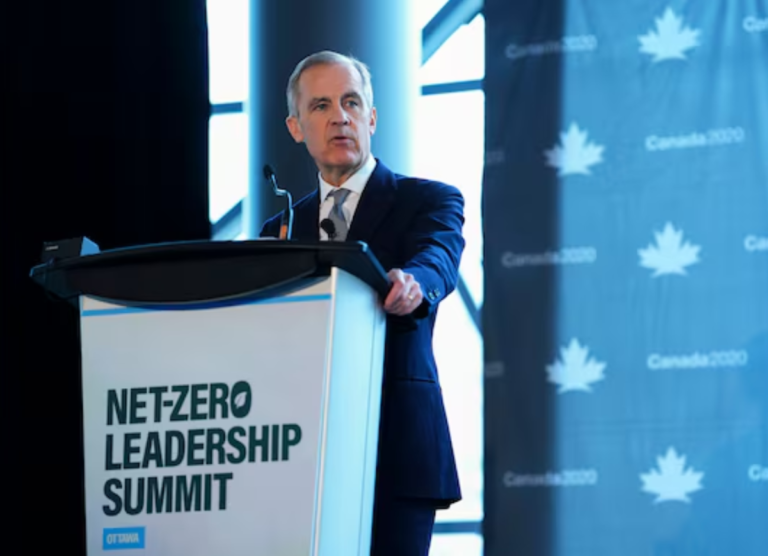
Mark Carney’s win signals a turning point for climate policy in Canada. Carney, the former Bank of Canada and Bank of England governor1, has long framed climate change as not just an environmental threat, but a systemic financial risk. From helping launch the Task Force on Climate-related Financial Disclosures (TCFD)2 to rallying over $130 trillion in assets under the Glasgow Financial Alliance for Net Zero (GFANZ)3, Carney has led the global charge to link sustainability with capital markets and has long warned that climate change poses systemic risks to the economy.
Now, he’s in a position to act on those warnings, and businesses need to be ready.
For sustainability leaders, SMEs, and forward-thinking executives, this means more than talk. It means regulation, investment, and competitive advantage will increasingly align with carbon performance
Highlights from Carney’s Climate-Economy Agenda:4
- Stronger Carbon Pricing and Clean Industry Incentives. The Output-Based Pricing Canada’s industrial carbon pricing system (OBPS) will be strengthened, with clearer, harmonized rules across provinces and improved offset protocols. The government is also exploring a carbon border adjustment to protect Canadian industries from international competitors with weaker climate policies.
Business impact: High-emitting sectors can expect continued pressure to reduce emissions, but also more predictability and incentives to invest in clean technology. Companies that act early could gain a competitive edge and generate revenue through high-integrity offsets
- Green Investment Tax Credits
Canada will continue rolling out six major investment tax credits covering clean electricity, clean technology, hydrogen, carbon capture, EV supply chains, and cleantech manufacturing. These credits aim to de-risk capital projects by sharing upfront costs with the federal government.
Business impact: Construction firms, fleet operators, rural service providers, and tourism-based SMEs all stand to benefit. Whether you’re building the infrastructure or adopting EVs, this is the moment to plug in.
- EV Infrastructure and Incentives
The plan promises thousands of new EV charging stations by 2027 and a return of the $5,000 federal rebate for zero-emission vehicle purchases. At the same time, tax incentives will support Canadian battery manufacturing and domestic supply chains.
Business impact: Opportunity will be available across the board: construction firms, fleet owners, tourism operators, auto suppliers, and clean tech vendors.
- Nature-Based Climate Solutions
Expect more funding for reforestation, soil carbon sequestration, and Indigenous-led stewardship programs. The government will also speed up the development of carbon offset protocols, making it easier to generate credits from verified nature-based activities.
Business impact: Environmental service providers, forestry contractors, agricultural SMEs, and First Nations enterprises could unlock new revenue streams through high-quality offsets and restoration work. - Mandatory Climate Risk Disclosures
There may be a push to Expand TCFD-aligned climate reporting across Canadian firms along with finalizing sustainable investment guidelines.
Business impact: Climate disclosure will become part of regular business operations, and firms with credible plans will attract more investment.
What Business Leaders Should Be Thinking About Now?
Carney’s platform is a blueprint for how Canada will build, power, and finance its next-generation economy. For business leaders, this moment is both a signal and an invitation to lead. Now is the time to:
- Assess your carbon exposure: Are rising industrial carbon prices a risk—or an opportunity to generate credits?
- Get EV-ready: Could your fleet or facility tap into infrastructure funding, rebates, or Charging-as-a-Service models?
- Leverage tax credits: Planning a capital project? Investment Tax Credits (ITCs) for clean tech, CCUS, or electricity upgrades can make the economics work.
- Begin your disclosure journey: Climate-related financial disclosures are no longer optional for firms seeking capital or credibility.
- Explore carbon removal roles: Tree planting, regenerative ag, or innovative tech like enhanced weathering could soon offer new revenue streams.
- Position for procurement and partnerships: Low-carbon credentials will increasingly affect how supply chains, investors, and governments choose their partners.
Firms that act now will be better positioned to secure funding, meet regulatory expectations, attract top-tier partners, and build long-term competitiveness in a net-zero economy.
And if you’re not sure where to start? That’s where we come in.
At YellowYellow, we help forward-thinking businesses make clean economy ambitions real – without the greenwashing. From carbon credit strategy and emissions reporting to EV infrastructure, grant applications, and fuel credit monetization, we turn policy into practical results.
The clean economy is here. Let’s make your business a leader in it.
Book a call with YellowYellow to get started. This is your moment to lead.
References:
- Bank of England (2015). Breaking the Tragedy of the Horizon – Climate Change and Financial Stability – Speech by Mark Carney. https://www.bankofengland.co.uk/speech/2015/breaking-the-tragedy-of-the-horizon-climate-change-and-financial-stability
- Task Force on Climate-Related Financial Disclosures (2025). About Us. https://www.fsb-tcfd.org/about/
- Glasgow Financial Alliance for Net Zero (2025). About Us.
https://www.gfanzero.com/about/
- Liberal Party of Canada (2025). A Cleaner, Greener Future. For Everyone. https://liberal.ca/climate/









